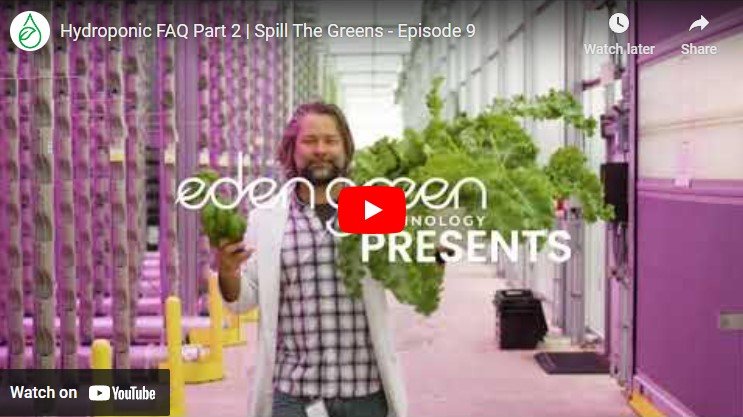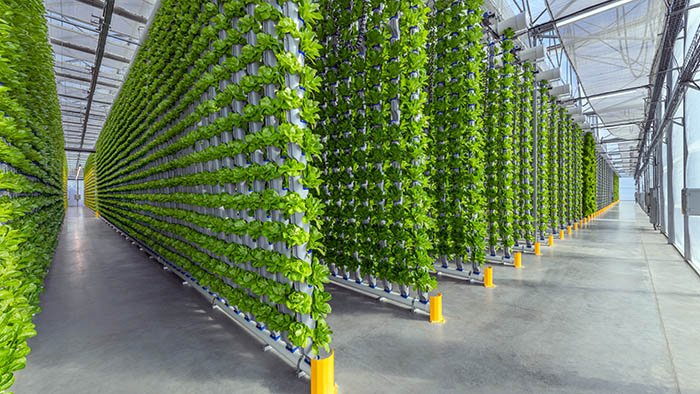Hydroponics vs Aeroponics: Key Differences & Similarities
Aeroponics and hydroponics are two growing methods gaining popularity. Many say they are the agriculture of the future, allowing us to feed a growing population despite climate and soil concerns. But what are these methods, and how do they differ? Read on to learn more about these fascinating agricultural methods.
The first thing to know about aeroponics and hydroponics is that one is a subset of the other. That’s right; aeroponic growing is one of the many hydroponic systems that growers use today. We’ll explain and get into the details of how these systems work below.
Join our Head of Horticulture as he explains hydroponics, controlled environment agriculture (CEA) and vertical farming.
What is Hydroponics?
Hydroponics describes a method of growing crops without the use of soil. Instead of pulling nutrients from the ground, plant roots get them from water. The idea is that plants are grown with their roots exposed. Growers then add nutrient solution to water and apply it to the roots directly. For more information, check out our page, What is Hydroponics?
There are several ways to set up such a system, and they each have to do with how the enriched water is delivered to the plants. These systems include:
Deep water culture (DWC) is where roots dangle in aerated water.
Nutrient film technique (NFT) is where water trickles past roots in a thin layer.
Ebb and flow (flood and drain) is where the roots are alternately flooded and drained.
Drip systems are where small emitters constantly drip directly onto plants or their roots.
Aeroponics, which we’ll explain in detail below.
Each system has its benefits and drawbacks, but the concept is beneficial in several ways. It uses less water than traditional farming, and plants can be grown indoors, away from the elements and contamination. It also allows growers to stack plants vertically, producing far more in a smaller space. Check out the Benefits of Hydroponics for more information.
What is Aeroponics?
As we mentioned above, aeroponics is a subset of hydroponic growing. In aeroponics, plants are grown with their roots dangling in the air. Below the roots are small emitters that mist the roots regularly, providing them with microdoses of water and nutrients.
| Aeroponics | Hydroponics | |
|---|---|---|
| Method of Nutrient Delivery | Plants receive nutrients from a mist sprayed onto their roots. | Plants may be suspended in water full-time or fed by an intermittent flow of water. |
| Design and Methodology | Farms are completely controlled and enclosed environments with crops growing suspended in air. | Farms are completely controlled and enclosed environments with crops growing in containers of nutrient-rich solution. |
| Plant Growth and Health | Plants grow in a sealed environment, reducing the risk of bacterial exposure. Roots are suspended, allowing aeration and oxygen intake. | Plants grow in a sealed environment, reducing the risk of bacterial exposure. Roots come into direct contact with nutrient-rich minerals resulting in increased growth. |
| Environmental Impact | Uses 99% less land than traditional farming, 98% less water, 85% less food miles, and requires fewer nutrients. | |
| Soil Requirement | Both methods don't require soil. | |
| Environmental Friendliness | Both are regarded as environmentally friendly compared to traditional farming. | |
| Use of Chemicals | Neither method requires the use of chemical fertilizers or pesticides. | |
Aeroponics vs. Hydroponics
Aeroponics is one of the most effective hydroponic systems. It’s nearly impossible to directly compare each system’s yield as many factors can influence plant growth. That said, aeroponic techniques yield about three times as much as soil-based growing methods. Overall, hydroponic systems can yield up to 20 times as much produce as soil-based growing.
Is aeroponics better than hydroponics?
Fans of aeroponic growing systems cite greater exposure to oxygen as a reason their preferred method is best. It’s true that when plant roots are constantly submerged, they can develop root rot. But most hydroponic systems do not constantly submerge the plants’ roots. The one that does (DWC) uses an air stone to aerate the water, providing the plant roots with all the oxygen they need to prevent rot. That said, an improperly calibrated hydroponic system can lead to root rot, but that doesn’t have to be the case if you’re careful in your setup.
What are the disadvantages of aeroponics?
There are a few reasons you might not want to start an aeroponic growing system.
Because water and nutrients are micro-dosed in these systems, the pH and nutrient density of the solution are crucial. The correct balance will provide you with healthy, thriving plants. But a solution that is even slightly off can harm your crops.
The cost of setting up an aeroponic system is relatively high. In some hydroponic options, like ebb and flow, home growers can easily assemble from inexpensive parts. But aeroponic systems need specialized equipment.
Power outages can cause severe disruption to your system, so if you’re not on a highly stable power grid, you’ll need to add a backup generator.
Indoor Vertical Hydroponics Systems
One of the best features of hydroponic growing is the ability to grow plants vertically. When plants don’t have to be anchored into the soil, they can be stacked high into the air, allowing growers to make the most of their space.
A common way of setting up a vertical aeroponic system is to grow plants in a column-like structure with emitters inside. This design is called an aeroponic tower. This tower structure can also work with other hydroponic systems and allows sunlight to reach all the plants on the tower. For more details, check out How Vertical Hydroponic Greenhouses Work.
Another common option is for growers to set up stacks of trays on shelving systems. The significant downside of this is that each tray shades the one below it. This means the system is heavily reliant on grow lights and uses a great deal of electricity to run.
DIY Hydroponic and Aeroponic Systems for Home
Surprisingly, it’s not too difficult to set up most hydroponic systems at home. If you’re only wanting to grow a few herbs on your kitchen counter, you can buy ready-made systems that have everything you need inside. If you’d like to set up a larger system, here are some starter guides you might find useful:
Hydroponics and Aeroponics Farms
While many home growers like to use hydroponic systems of various types to grow plants indoors, commercial growers are adopting the concept. These hydroponic or aeroponic farms are very like their home counterparts, done on a large scale.
Hydroponic farming is an exciting movement in the commercial agriculture space. It’s a method of growing that can produce high yields of healthy, fresh foods with minimal space and in a sustainable way when done correctly. It’s also climate agnostic: hydroponic greenhouses operate regardless of climate, season, or weather conditions. To learn more about these amazing advances, check out Hydroponics vs. Traditional Farming.
Environmental Impacts of Hydroponics and Aeroponics
Aeroponic and other hydroponic systems benefit the environment in several ways. These include:
No soil use, which means no soil depletion
Higher yields
Less water use
Growing in a smaller space, including urban agriculture
A cleaner environment and better food safety
Less food waste
Check out The Future of Controlled Environment Agriculture for more information about how this type of farming can benefit our world.
Growing with Eden Green Technology
If you’re looking for a source of hydroponic food for your grocery store or other retail establishment, we have great news. There’s an easy way to get the freshest, top-quality products at an affordable price.
Eden Green Technology is your ideal partner in revolutionizing the food industry. Here's why:
Variety: Choose from over 200 commercially viable produce options.
Customization: Benefit from white-label produce options, including specialized salad blends, fresh herbs, and more. Design your hydroponic produce program.
Quality: Our produce meets the highest industry standards and is available year-round, irrespective of climate or season.
Don't just read about the future of agriculture—be a part of it. Take the first step in aligning your business with sustainability and community impact.
🌱 Check out Eden Green's Sustainability Mission
Become a part of the solution. Let's grow together for a healthier, more sustainable world.





